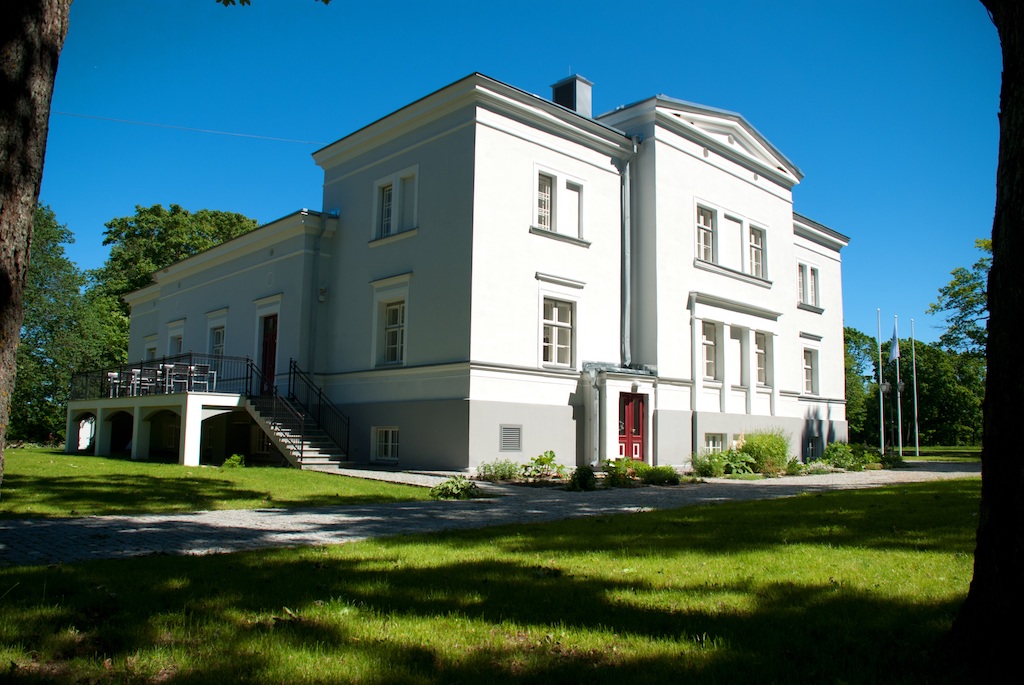The Manor is reborn

The story of how Soviet coast guard barracks have become the pearl of North-Estonian coastal cliffs
The story of the restoration of Saka Manor began in the summer of 2001, when the Estonian government held a public auction and sold the main residence to a private owner. It was the third attempt. There had already been two earlier but failed attempts to sell the building.
The new landlord was Tõnis Kaasik. This is his story: “In that moment, my decision was influenced by emotions and the 30-year-old memory of a day spent in the yard of the manor when a border guard detained me. The story began on 1 May 1971, when, as a geography student at the University of Tartu, I was finishing up fieldwork for my final project about the cliff waterfalls in northern Estonia.
All of the falls were within the Soviet border zone, where special permission was needed to attain access, but one of the waterfalls in particular, the 23-metre Karjaoru falls in Saka, was situated directly next to a border guard station. So, the measuring and photographing of the Saka cascade resulted in my arrest. A day spent staring into the barrel of a gun outside the mansion that was being used as barracks – that was my first experience at Saka Manor”.
“I finished the chapter on the Saka waterfall in my graduation thesis with the foretelling sentence: “Saka deserves better”. And 30 years later destiny gave me the opportunity to make my words come true, when the Ida-Virumaa County government in 2001 declared for the third time a public auction to sell the ruins of Saka Manor.
Two earlier auctions had failed”. The sale was made unattractive by the fact that the mansion’s ruins, along with a crumbling garage and an officers’ residence, were to be sold as movable property, i.e. without the surrounding land. Another problem was that the estate did not include a former Soviet border guard tower, which was located in the middle of the privatized property. The building was, nevertheless, later acquired with the help of the Kohtla municipal government and integrated into the estate.
The manor’s location in the most attractive part of a 1,200-kilometre limestone shore – the Baltic Klint – and the Estonian government’s plan to request the extensive landform to be granted the status of a World Heritage Site by UNESCO led to the idea of converting Saka Manor into a first-rate tourism center for the visitors of the beautiful coastline along with all the services needed by tourists. It felt like a perfect chance to offer an exciting experience to both nature and culture enthusiasts.
Renovating the crumbling mansion, polluted and overgrown estate and the neglected park, which had lain abandoned for a decade, required large investments and endless persistence.
The restoration progressed one step at a time. In the spring of 2004, doors opened for the former officers’ residence, which had been rebuilt into a restaurant and the Saka Cliff Hotel. Next, the border guard tower on the edge of the steep rocky coast was converted into Meretorn, accommodating four seminar rooms, while the military storehouse was turned into a camping lodge with public bathrooms and washrooms for caravan tourists.
Trails were built in the park and a parking lot was added for cars. Finally, the restored mansion itself was reopened in 2010, for which Tõnis Kaasik merited honors as the National Heritage Board’s best partner in 2010 and Ida-Virumaa’s person of the year in 2011.
Previously visible from the 50-metre-high limestone bank, but intangible, the seashore and beautiful sandy beach were made accessible for holidaymakers with two stairways, which earned an award for one of the architects, Tiit Kaljundi. From the landing of the stairs, one can gaze into the interior of the so-called “Nordic rainforest”, with its broad-leaved trees and abundance of ferns. The unique Estonian forest type has been named Estonia clivosa of the Baltic Klint by a noted Estonian botanist Teodor Lippmaa.
In subsequent years, the hotel was extended to include a wellness spa with a swimming pool; the gravel pit once used as a dump by the Soviet military was converted into an amphitheater; and tennis and beach volleyball courts were built. Some military structures and trenches were restored as part of the Klindimõisa hiking trail. Thus, the story of the rebirth of Saka Manor describes how a Soviet border guard outpost became the pearl of northern Estonia’s steep rocky shoreline.
Join the newsletter
